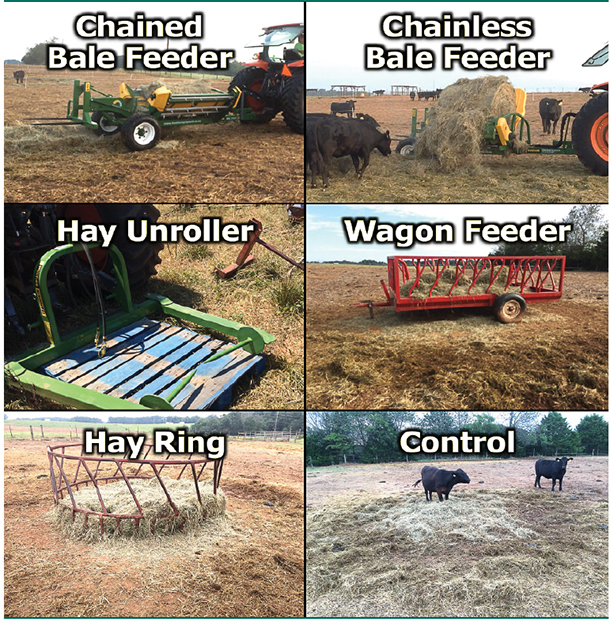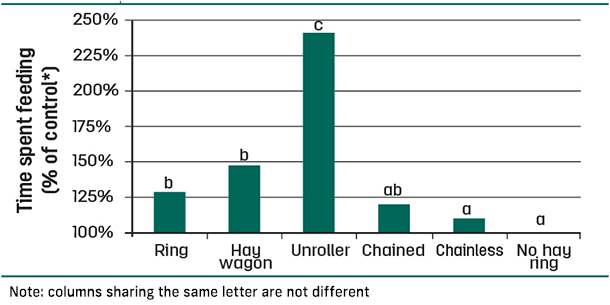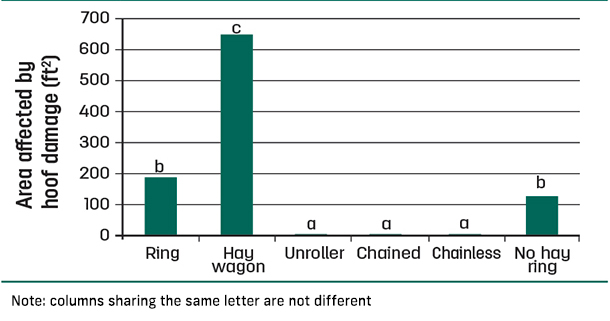Ways to minimize the impact of hay feeding
My last article was about how to reduce wastage by limiting access to feed. Though minimizing wasted forage and being cost-effective is a key concern, it is far from the only worry. For most livestock farms/ranches, the main reason for allowing unlimited access to hay is the time and convenience. So today, we’ll be comparing different methods of feeding out hay, and you’ll see that the fastest method isn’t always the one you’d think.
An interesting study has been published by Dennis Hancock, Forage extension specialist at the University of Georgia where he compared the time expended feeding dry hay in six 1.7-acre (0.4-hectare) pens of beef heifers. The University of Georgia used different typical feeding methods and various sets of equipment available on the market:
- a mechanized chain bale feeder/processor
- a mechanized chainless (rotors) bale feeder/processor
- a hay unroller
- a hay wagon
- a hay ring
- a control (unprotected bale)

In order to be closer to real farming conditions, the time spent to feed out bales to the heifers was recorded from the moment the bale was loaded from the storage area until the pen was exited after feeding out the bale. Dennis Hancock also explained that they chose to withhold the transport time of the study in order to eliminate any differences in distance between the storage area and the pens. Also, the methods were replicated four times and simultaneously.
How long does it take to feed out a bale?
Dennis Hancock noticed the following results:
- a little to no difference in the time spent loading the bales at the storage area
- a difference in the amount of time it took to feed the bales
As you can see in the table below, it obviously takes more time to feed out than simply placing the bale in the field without protection (what Dennis Hancock called the “Control” method). But the interesting part is that Dennis Hancock noticed that “the mechanical bale feeders unroll and pull apart the bale more aggressively than simply unrolling the bale across the ground, but are less destructive than a bale grinder. Those feeders did not add a significant amount of time to feed a bale when compared to simply placing the bale”. However, using a hay ring increases the amount of time to feed a bale by about 30% because the hay ring has to be repositioned – moving it off the previous spot and over the new bale. The University of Georgia used the fork of a front-end loader to do so, but in practice some farmers do this by hand. The hay wagon also takes time because it has to be unhooked from the tractor’s drawbar by hand. The bale unroller is by far the most time-consuming method, requiring nearly 2.5 times as much time to feed a bale.

The impact of feeding on your soil
So Mr. Hancock found that using a mechanized chain bale feeder/processor or a mechanized chainless (rotors) bale feeder/processor doesn’t take much longer than simply placing a bale in a paddock. However, the effects of feeding hay in a certain area can often be felt for months or even years. Any farmer or rancher could see an aerial picture of a farm or ranch, and instantly located where they feed out their hay.
The physical damage to the ground from the hoof traffic (resulting in soil compaction) and the thickness of the residue left behind after the hay feeding period was also been measured by Dennis Hancock, and the results are in the table below.

What does this tell us about sustainable bale feeding practices?
- Soil disturbance has a huge impact on soil erosion
Soil erosion has become a massive issue worldwide for the farming industry. In large parts of the world, including North America, Europe or Australia, the problem has become so severe that the land can no longer be pastured and must be abandoned, repurposed, or require years and years of intensive care to be back to an average condition.
- The areas affected by damage will likely run off nutrients
Animal manure and urine is likely to be more concentrated in these areas as well. As a result, the concentration of nutrients in these areas prevents the utilization of those nutrients across the whole pasture and may increase the risk of nutrient runoff.
- There is no perfect hay feeding system, but sustainable farming habits can be easily adopted
With definite pros, cons and trade-offs with each method, farmers can adopt sustainable farmings methods, balancing cost-efficiency and time-efficiency while minimizing the long-term impacts.
In the next article, we’ll study a bit more acutely the benefits of feeding bales evenly and how that can effect manure spreading, pasture damage reduction and pasture reseeding. In the meantime, feel free to peruse “8 benefits of rotational grazing” for similar information.


























